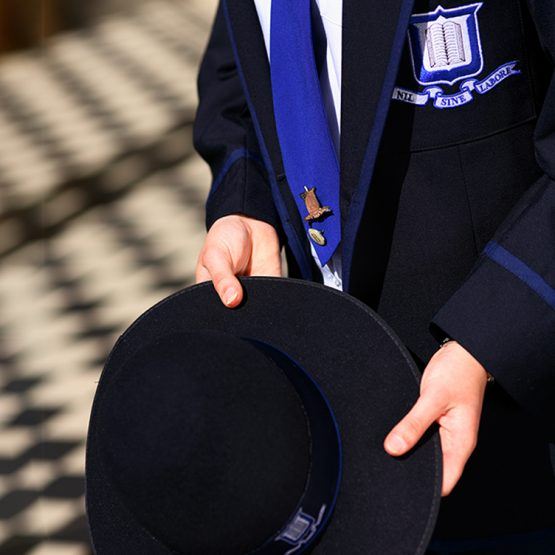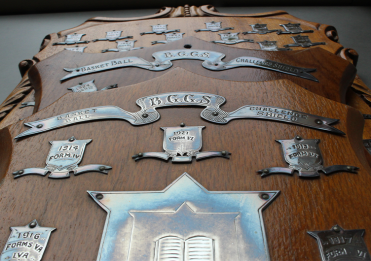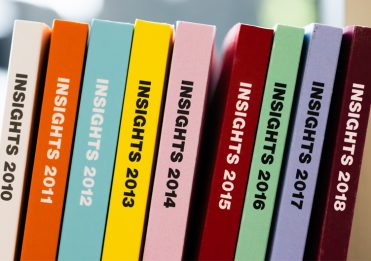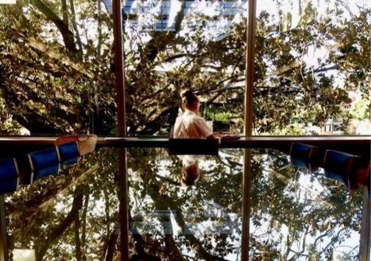In a quiet, elevated position on the Eastern side of Main Building sits a busy abode—home to our Girls Grammar native bees.

2022—The BGGS Beehive
Early in 2018, through an initiative of Mrs Anna O’Gorman, the School invited Dr Tobias Smith of Bee Aware Kids to share native beekeeping guidance with the Grammar Environmental and Conservation Organisation (GECO) and interested students. When the beehive was introduced later in the year, as an initiative of GECO, its captains, Christina Chan (2018) and Sachi Wilson (2018), and staff coordinators Ms Chris Woodford (Jones, 1972) and Mr Gideon Huppert, initially hoped it would contribute to increasing the local bee population and raise awareness of declining bee populations around the world. Five years on, our buzzing hive is achieving both our goals, and contributing to a nationwide research project!

Native bee—Tetragonula hockingsi
Our tiny (3–5 mm), black stingless native bees are from the species Tetragonula hockingsi. In the wild, these native bees often nest in tree hollows, as they do at our Marrapatta campus, or in water meters and walls in an urban environment like Brisbane. Our bees are one of 1700 species of Australian native bees and, while many of these species remain solitary, our BGGS bees are social creatures—living as a collaborative, hard-working colony. The queen bee spends all her life in the hive, sharing space with her worker daughters and male drones—thousands of bees buzzing around the beautiful Grammar gardens.

2019 Service Captains: Gemma Grattan (12O) and Victoria Hogan (12W)

2020—Inside the BGGS native beehive
Towards the end of 2022, an opportunity to participate in The University of Queensland’s (UQ) Native Bee Citizen Science Project was identified by the Communications and Engagement Team. The GECO Club jumped at this chance to observe the bees, collect data, and contribute to research about how Australian stingless bee colonies reproduce. Prior to the start of the research, an important hive health check was carried out as low activity had been noted—not unusual as native bees prefer temperatures above 20 degrees. However, the culprit was not the cold but something a little more sinister. Thanks to Mr Rob Hetherington in Property and Facilities, the bees are now elevated out of reach from our resident Eastern Water Dragons (Intellagama lesueurii).
2023 GECO student leaders—Cara Battaglia (12H), Isabella Byrne (11M), Evie Kolff van Oosterwijk (11M), Emily Wells (11E), and Ellie Wild (12R)—and staff coordinators—Mrs Sacha Cross and Ms Caitlin Simic—collaborate as Citizen Scientists every Monday lunch to observe the hive and record key bee behaviours. Mrs Cross shares:
‘The native bees at BGGS are much-loved members of the GECO community. When we count our bees, often other students will stop to ask us what we are doing and it’s a great opportunity for them to spread the word about the importance of the bees. As little is known about native bees the students also like to discuss their roles as community scientists and explain that they are sharing our data with UQ. As a Science teacher, it is also wonderful to observe the students applying the skills they have gained in their curriculum Science lessons regarding data collection, to real-life scenarios.
‘My favourite part of our citizen science project is that the bees allow the students to recognise that all environmental factors are interconnected in the living world. What we do in our School environment can have great impacts on our bee-loved bees (pun intended), so the students always have the welfare of the bees in mind when planning for future projects. We are currently discussing how to increase the native biodiversity around the School for our bees—our bees care for us by pollinating our native flora, so we like to care for our bees in return.’
The School’s hive is one of more than 400 registered in Australia, and one of more than 300 in Queensland, providing important data for the project. Ultimately, the aim of UQ’s research is for the findings to be published in a few years’ time and shared with the world—a starring role for our BGGS bees and scientists!

So, what keeps our bees busy? While students and staff are occupied around the School, our bees are flying up to 500 metres from the hive to collect pollen, nectar, and resin from other trees and flowers across the Spring Hill Campus and Barrambin (Victoria Park). Next time you’re passing by the hive, look for the bees returning with balls of (usually) yellow pollen on their back legs. Back in the hive, they’re also busy making small amounts of tangy-tasting honey, though much less than non-native honeybees. No holidays for these Grammar residents—they’re busy bees all year!
With a health check in Term 4 2023, we are hoping the colony will be buzzing and ready to be split for relocation to Rangakarra or Marrapatta campuses to continue the research with UQ, and further share the importance of the role our School environment plays in maintaining biodiversity and healthy ecosystems locally, nationally, and globally.
Ms Robyn Osborn
Communications Project Manager
References
2022 GECO and Grammar Goes Green History unpublished.
BGGS Magazines 2018, 2019, 2020, 2022.
Cross, Sacha email 12.07.23
https://environment.uq.edu.au/community/native-bee-citizen-science-project




